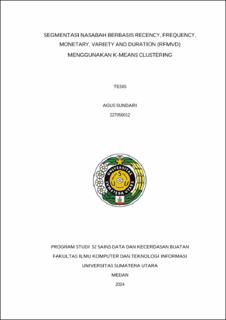Segmentasi Nasabah Berbasis Recency, Frequency, Monetary, Variety and Duration (RFMVD) Menggunakan K-Means Clustering
Customer Segmentation Based on Recency, Frequency, Monetary, Variety and Duration (RFMVD) Using K-Means Clustering

Date
2024Author
Sundari, Agus
Advisor(s)
Lydia, Maya Silvi
Muchtar, Muhammad Anggia
Metadata
Show full item recordAbstract
In banking, maintaining customer retention and customer satisfaction are important. Effective customer segmentation can be a strategic tool to improve customer loyalty and business performance. This research can assist banks in developing marketing strategies to retain customers and improve services based on bill payment transactions. The data that will be used in this study is bill payment transaction data at regional banks in 2023, as for the types of bill payments made by customers, namely electricity, water, telephone payments, and internet bills. The amount of data used is 702,174 rows. This research uses K-Means clustering to group customers based on recency (the last time the customer made a transaction), frequency (the number of customers making transactions), monetary (the nominal amount of money spent by the customer), variety (the number of types of bills paid) and duration (the average duration of time the customer makes the previous transaction until the next transaction) (RFMVD). The results of customer segmentation based on recency, frequency, monetary, variety and duration using K-Means clustering produce 3 customer groups, namely passive customers, loyal customers, and VIP customers. The silhouette score value on customer segmentation using K-Means clustering is 0.7303, which indicates that the grouping is quite good and the number of clusters is correct.
Collections
- Master Theses [20]
